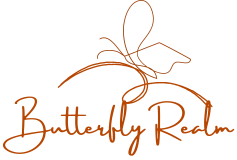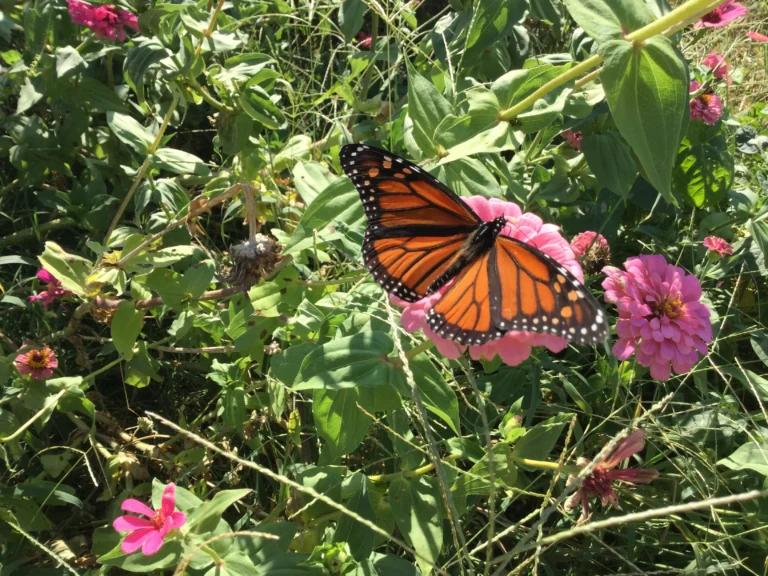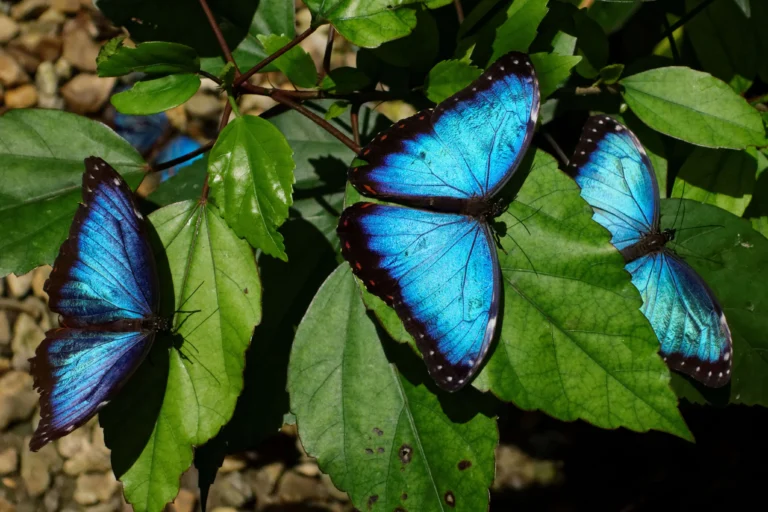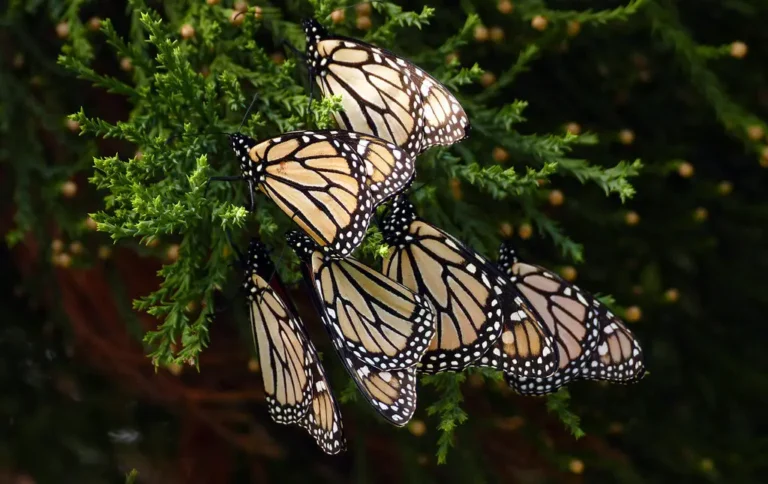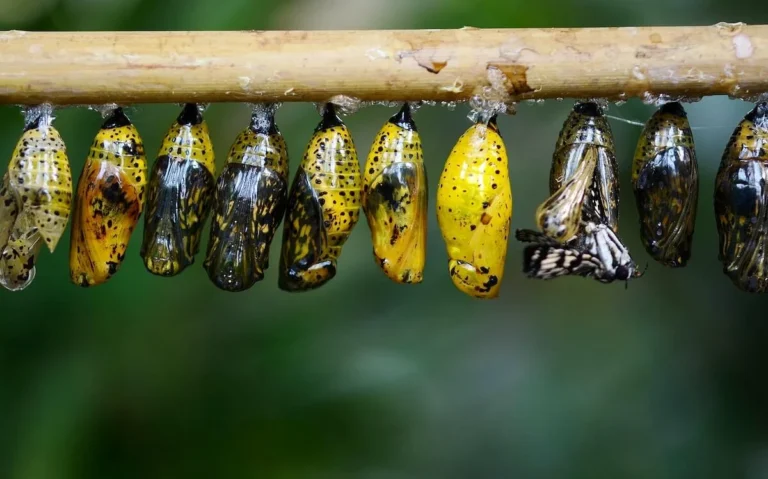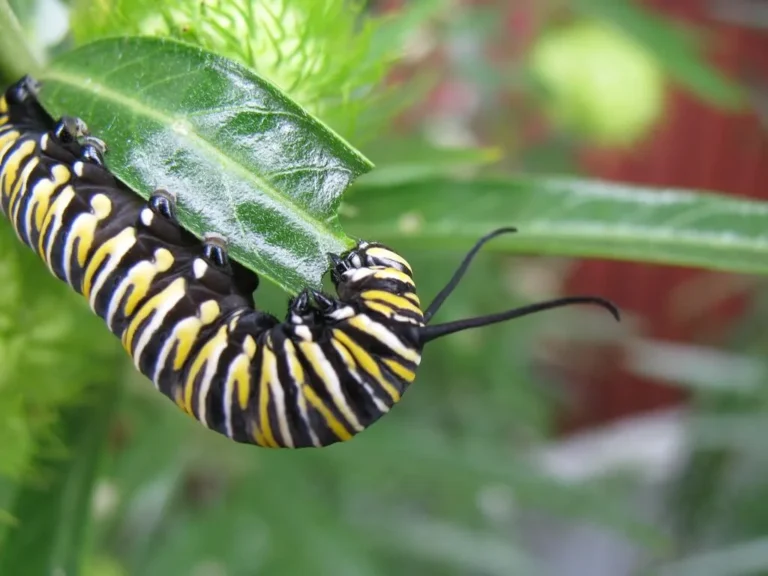Discover Butterflies & Moths That Look Like Monarchs: A Detailed Guide
Quick Summary Of Butterflies That Look Like Monarchs: Many butterflies look like monarchs to stay safe. This includes the Viceroy, Queen, and Soldier butterflies. Some, like the Painted Lady and the bright Danaid Eggfly, have colors or patterns that are a lot like monarchs. This clever trick helps them keep away from danger in the wild. It’s a smart way nature helps them live and adds more beauty to our world.
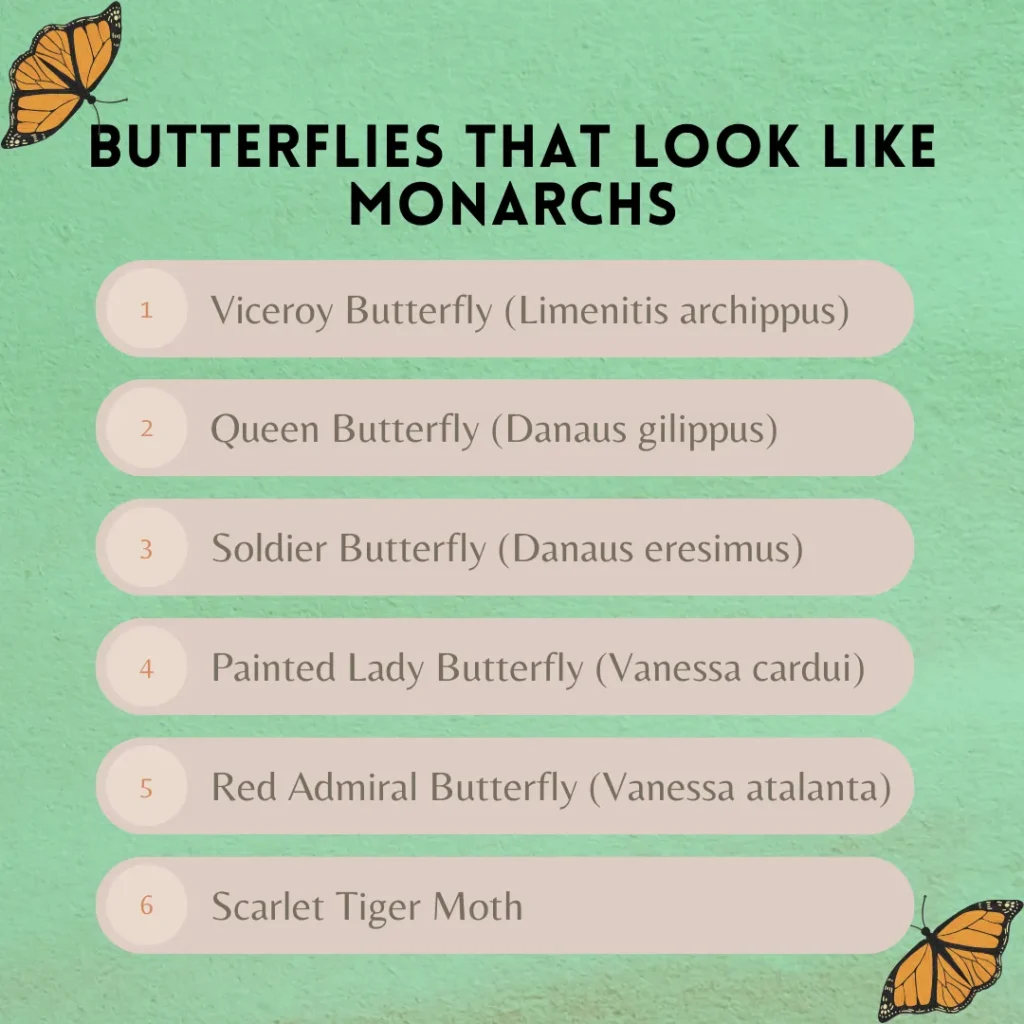
Table of Contents
Introduction
Hey butterfly enthusiasts! Are you curious about the colorful world of butterflies that look strikingly similar to the famous monarch butterflies? You’ve landed at the right place! Let’s jump right in and explore this fascinating topic.
Did you know that there are several butterflies that bear a strong resemblance to monarchs? It’s not just a coincidence! There’s a natural phenomenon at play here. But before we get into that, let’s talk about why it is important to know about these “lookalikes”.
Identifying butterflies that look like monarchs can be a fun and educational experience. It not only adds a layer of excitement to butterfly watching but also helps in understanding the rich diversity in the butterfly kingdom.
Moreover, being able to distinguish between different butterfly species is vital for conservation efforts and to maintain a healthy ecosystem.
you might also be curious to understand if monarch butterflies are poisonous
So, why wait? Let’s jump into this colorful adventure and learn about the butterflies that are often mistaken for monarchs. Grab a cup of coffee, and let’s get started!
Butterflies Most Commonly Mistaken for Monarchs
The beauty of the butterfly world is truly mesmerizing. In this section, we are going to talk about butterflies that are often mistaken for monarchs because of their striking similarities.
It’s quite a common scene in the butterfly community to stumble upon a butterfly and wonder, “Is that a monarch?” So, let’s take a closer look at these wonderful creatures.
Viceroy Butterfly

- Appearance: At first glance, the viceroy butterfly can easily be mistaken for a monarch. They both share a vibrant orange hue coupled with black markings and veins across their wings. The viceroy, however, is slightly smaller in size compared to the monarch, and it features a distinct black line across the hindwings which monarchs lack.
- Differences from monarchs: Aside from the notable black line across their hind wings, viceroy butterflies also have a different flight pattern. While monarchs glide gracefully, viceroys have a faster and more fluttery flight.
- Habitat and range: You can often find viceroy butterflies near wetlands and marshes, where their favorite food, the willow trees, are abundant. Their range primarily covers North America, stretching from the Canadian provinces down to Mexico.
To further enhance your understanding, explore the significance of the yellow monarch butterfly which also shares a similar range.
Queen Butterfly

- Appearance: The queen butterfly is another doppelganger in the butterfly world, sharing a close resemblance to monarch butterflies. They have a rich orange-brown color palette with white spots on their wings. While their color might be a bit more subdued compared to the vibrant monarchs, their striking similarity can sometimes be a cause for confusion.
- Differences from monarchs: Queen butterflies lack the black veins that are a prominent feature on the wings of monarch butterflies. Additionally, they have a different pattern of white spots on their body and wings, which helps in distinguishing them from monarchs.
- Habitat and range: These butterflies are native to North and South America, and commonly found in warm climates. They enjoy open, sunny areas and are often spotted fluttering around milkweed plants, their primary food source.
Speaking of food, discover what monarch butterflies eat in our dedicated article that discusses their diet in detail.
Soldier Butterfly

- Appearance: Soldier butterflies are yet another species that share a family bond with monarchs. They boast a similar orange and black color scheme, which can sometimes make it challenging to tell them apart from monarchs, especially for beginners.
- Differences from monarchs: Soldier butterflies have more subdued coloration compared to monarchs, and their wings have a more rounded appearance. The patterns on their wings are also different, with fewer white spots compared to monarch butterflies.
- Habitat and range: Soldier butterflies predominantly thrive in the southern United States, Central America, and parts of the Caribbean. They prefer subtropical environments and are often seen around forests and meadows.
You might also find it interesting to learn about the monarch butterfly migration, a phenomenal journey covered by the monarch butterflies.
Now that we have introduced you to the top three butterflies that are often mistaken for monarchs, it’s time to explore some more butterflies that bear a noticeable resemblance to monarchs.
Butterflies That Bear a Strong Resemblance to Monarchs
In this section, we are going to meet butterflies that, although not frequently confused with monarchs, showcase a noticeable resemblance to them. Let’s get acquainted with these beautiful creatures that grace our gardens and parks with their presence.
Painted Lady Butterfly

- Appearance: The painted lady butterfly is a true artist in the butterfly world. With a canvas of delicate wings adorned with a mosaic of orange, black, and white patterns, it paints a picturesque scene in any garden. While not exactly mimicking the monarch, the splash of orange can sometimes cause momentary confusion.
- Differences from monarchs: A closer look reveals the differences. The painted lady has a more complex and mosaic-like pattern on its wings compared to the simpler and bolder patterns of the monarch. Moreover, they are slightly smaller in size.
- Habitat and range: Painted ladies have a vast range, covering Europe, Asia, Africa, and North America. They are true globetrotters, adapting to various habitats including gardens, meadows, and open fields.
Red Admiral Butterfly

- Appearance: The red admiral butterfly wears a cloak of mystery with its dark, almost black wings highlighted with bands of red and white spots. The splash of red can sometimes be mistaken for the orange hue of the monarchs, especially when fluttering quickly between flowers.
- Differences from monarchs: The red admiral has a darker base color compared to the vibrant orange of the monarch. The white spots and red bands on its wings make it distinguishable from the monarch’s patterned wings.
- Habitat and range: These butterflies are found in temperate regions like North America and Europe. They enjoy gardens, woodlands, and marshes, where they can easily find nettles, their preferred food source during the caterpillar stage.
Scarlet Mormon Butterfly

- Appearance: The scarlet Mormon, with its grand and flamboyant display of vibrant red and black hues, can sometimes be mistaken for a monarch due to the fiery colors it shares with the monarch.
- Differences from monarchs: Although they share a similar color palette, the patterns are markedly different. The scarlet Mormon flaunts bold red strokes on a black canvas, quite different from the black veined pattern on the orange background of the monarch.
- Habitat and range: Native to Southeast Asia, these butterflies prefer tropical habitats. They are often seen flitting gracefully in forests and gardens, showcasing their vivid colors.
Butterflies with Some Resemblance to Monarchs
In this segment, we’ll introduce you to butterflies that possess some similarities with the renowned monarch butterflies. These butterflies might not be twin siblings of the monarchs but certainly share some family traits.
Let’s get to know them better.
Two-tailed Swallowtail

- Appearance: This butterfly is a sight to behold with its vibrant yellow and black patterned wings. Its defining feature, the two elongated tails extending from the hindwings, makes it a distinctive sight in the butterfly realm.
- Differences from monarchs: Aside from the obvious difference in color, the two-tailed swallowtail sports striking black stripes and a splash of blue and orange near the tail, which are absent in monarch butterflies.
- Habitat and range: Commonly found in North America, these butterflies prefer woodland edges and open fields where they can easily access nectar from a variety of flowers.
Danaid Eggfly or Mimic

- Appearance: Known for its varied appearances, the danaid eggfly exhibits different patterns and colors, often mimicking other butterfly species, including the monarch at times with its orange and black combination.
- Differences from monarchs: Though it can bear a resemblance to monarchs, the patterns are usually more scattered and less defined compared to the symmetrical patterns of the monarch butterfly.
- Habitat and range: These adaptable butterflies are found in various habitats across Asia, Africa, and Australia, from lush forests to bustling gardens.
Gulf Fritillary

- Appearance: The Gulf Fritillary enchants with its bright orange wings speckled with black spots. At a quick glance, it can remind one of a monarch butterfly due to its similar color palette.
- Differences from monarchs: Upon closer inspection, the array of black spots and the more elongated wing shape set it apart from the smoother patterns and rounded wings of the monarch.
- Habitat and range: Predominantly found in the southern parts of the United States, these butterflies enjoy open spaces like gardens and meadows where they can flutter freely.
Get to know more about the fascinating monarch butterfly symbolism which has enchanted people for generations.
American Lady Butterfly

- Appearance: Sporting a vibrant display of orange and brown with intricate patterns, the American lady butterfly presents itself as a mosaic artwork, captivating the attention of butterfly enthusiasts.
- Differences from monarchs: While the color palette might resemble the monarchs, the American lady has a more mosaic-like pattern with prominent eyespots on the hindwings, distinguishing it from the monarch butterfly.
- Habitat and range: These butterflies are commonly found across North America, favoring open habitats like fields and gardens where they can easily find nectar.
Admiral Butterfly

- Appearance: The admiral butterfly dons a rich maroon cloak adorned with bands of white and orange, offering a majestic sight for those lucky enough to spot one.
- Differences from monarchs: The darker background color and the contrasting white stripes make it quite different from the orange and black patterns of the monarch butterflies.
- Habitat and range: You can spot these beauties in North America and Europe, typically in woodlands and gardens where they find abundant food sources.
Common Buckeye Butterfly

- Appearance: With a striking pattern of eyespots and varied hues of brown and orange, the common buckeye butterfly captures the imagination of everyone who encounters it.
- Differences from monarchs: The eye spots and the rich, brown base color of the wings set it apart from the vibrant orange wings of monarch butterflies.
- Habitat and range: They thrive in North America, particularly enjoying sunny open areas where they can bask in the sunshine.
Pearl Crescent Butterfly

- Appearance: This small butterfly graces the surroundings with its delicate orange and black patterned wings, adding a touch of beauty wherever it flies.
- Differences from monarchs: Its smaller size and the intricate black patterns scattered across the wings distinguish it from the more prominent and bold patterns of the monarch butterfly.
- Habitat and range: Predominantly found in North America, these butterflies enjoy meadows and open fields, fluttering happily in the sun.
We hope you enjoyed meeting these butterflies that, although not exactly resembling monarchs, share the stage with them in the grand butterfly show of nature.
Coming up next is an exciting section on mimicry, where we unveil the secrets behind the art of imitation in the butterfly world.
Mimicry in Butterflies
Nature is an expert artist, and one of its most captivating paintings is the phenomenon of mimicry.
In this section, we will explore how mimicry serves as a survival tool in the butterfly world, with a special spotlight on the butterflies that resemble monarchs.
Let’s discover the secrets that lie behind those vibrant wings.
Explanation of Mimicry
Mimicry is a fantastic strategy that many butterflies use to deceive predators and increase their chances of survival. Here’s how it works:
- Batesian Mimicry: This is where a harmless butterfly imitates the appearance of a harmful or toxic species, thus deterring predators who mistake it for the harmful species. Monarchs, known to be toxic due to their diet of milkweed during the caterpillar stage, often find themselves being mimicked by other non-toxic species.
- Müllerian Mimicry: In this type, two or more harmful species resemble each other, creating a mutual benefit where predators learn to avoid them all, enhancing the survival rate of each species.
How it Helps in Survival
Understanding mimicry isn’t just a fascinating insight into the natural world, but a glimpse into survival strategies that have been honed over millennia. Here is how mimicry contributes to survival:
- Predator Confusion: Predators often get confused with the similarities and avoid attacking the mimics, fearing the consequences they have experienced with the toxic species.
- Energy Conservation: By not having to constantly flee from predators, mimicking butterflies can conserve energy for other essential life processes, such as reproduction and feeding.
- Increased Lifespan: Naturally, avoiding predation often leads to a longer lifespan, allowing these butterflies more opportunities to reproduce and pass on their genes to the next generation.
Mimicry showcases the intelligence of Mother Nature, granting butterflies an edge in the harsh realities of the wild.
It not only adds to the beauty and diversity of these flying jewels but also serves as an evolutionary marvel that continues to puzzle and fascinate scientists and enthusiasts alike.
Moths That Resemble Monarchs
In the splendid world of fluttering wings, not only butterflies but also some moths have hopped onto the mimicry bandwagon, sporting patterns and colors similar to those of monarch butterflies.
Let’s take a closer look at these remarkable creatures and explore how their likeness to monarchs plays a role in their survival.
Overview of Moths that Resemble Monarchs
Moths, usually associated with the night, have a different lifestyle compared to butterflies. Yet, some of them share striking resemblances with monarch butterflies.
Here’s an overview of why and how these moths look like the beautiful monarchs:
- Defensive Strategy: Just like butterflies, moths also use mimicry as a defensive strategy. The moths that look like monarchs often escape predation, thanks to the predator’s previous experience with the unpleasant taste of monarchs.
- Camouflage: Mimicry also acts as a form of camouflage, helping these moths blend in with the surrounding butterflies, which can sometimes deter predators who are specifically hunting for moths.
Detailed Profiles of Various Moths
Now, let’s introduce you to some moths who have mastered the art of mimicry:

- Milkweed Tussock Moth:
- Appearance and Resemblance to Monarchs: These moths have a bold pattern with bright orange and black colors which make them look somewhat like the monarchs.
- Differences from Monarchs: Despite the color similarities, their body structure and wing shape are notably different from monarchs.
- Habitat and Range: Commonly found in North America, particularly in areas with abundant milkweed plants.
- Banded Tiger Moth:
- Appearance and Resemblance to Monarchs: Sporting a vivid orange hue with hints of white and black, these moths carry a strong visual semblance to monarch butterflies.
- Differences from Monarchs: They have a more stout body compared to the sleek frame of monarch butterflies.
- Habitat and Range: These are primarily found in southern regions of the United States and in Central America.

By resembling monarchs, these moths have turned the tables in their favor, utilizing their appearance as a shield against potential predators.
This mimicry phenomenon is not only a testament to the intricacies of nature but also a beautiful representation of the interconnectedness of life on Earth.
Also, catch a glimpse of the stunning blue monarch butterfly in our special feature article that reveals the mystery behind its blue color.
FAQs
In our journey through the fascinating world of butterflies and moths that look like monarchs, several questions might be bubbling in your mind. Let’s address some of these frequently asked queries to provide you with a well-rounded understanding of this topic.
Are there butterflies that look like monarchs but aren’t?
Absolutely, there are several butterfly species that bear a striking resemblance to monarchs, both in color pattern and wing shape. These include the Viceroy, Queen, and Soldier butterflies, among others.
This resemblance is often a result of mimicry, a survival strategy adopted to deter predators.
What are the small/yellow/blue butterflies that look like monarchs?
Small Butterflies: The Pearl Crescent is a smaller butterfly that exhibits some resemblance to the monarch, primarily in its color scheme.
Yellow Butterflies: The Two-tailed Swallowtail showcases a yellow and black pattern, bearing similarity to the monarch, especially in terms of color distribution on the wings.
Blue Butterflies: The Danaid Eggfly, also known as the Mimic, sports a blue hue but carries patterns and wing shapes that can sometimes resemble those of the monarch.
Is there a moth that looks like a monarch butterfly?
Yes, there are a few moths that resemble monarch butterflies, including the Milkweed Tussock Moth and the Banded Tiger Moth.
These moths have adopted similar color patterns as monarchs as a part of their survival strategy, making the world of moths as fascinating and diverse as that of butterflies.
What is the difference between a monarch and a viceroy butterfly?
Though they look quite similar, there are subtle differences between the monarch and viceroy butterflies.
The viceroy is slightly smaller and has a black line running across its hind wings, which the monarch lacks. Additionally, while monarchs are known for their migratory behavior, viceroys tend to be more sedentary.
Conclusion
As we finish our bright and colorful journey into the world of butterflies and moths, we all can say that nature is full of amazing surprises.
It’s really cool to see how some species look very much alike to help them survive. It’s almost like a magic trick!
We have taken a close look at different butterflies that look like monarchs, which can sometimes trick even the most careful watchers.
We saw butterflies like the viceroy and queen, which look very much like monarch butterflies. We also saw others like the two-tailed swallowtail and Danaid eggfly, which share a family resemblance.
We didn’t forget about moths, who also join in this game of pretending to keep safe from animals that might want to eat them. We saw the bright colors of the milkweed tussock moth and the banded tiger moth, which show the true beauty of nature.
But it’s not just about how they look. It’s also about keeping these beautiful creatures safe and sound. They help keep nature in balance, which helps us too.
As we learn more, let’s remember how important these flying beauties are. Let’s work together to keep their homes safe, which also helps keep our Earth healthy.
By learning and knowing more about these butterflies and moths, we become better friends with our environment.
Remember, every wing flutter matters in the big picture of nature.
